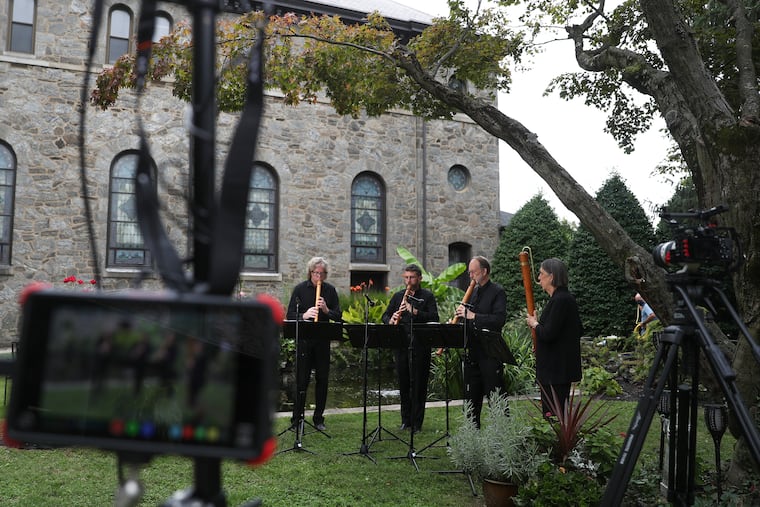A carillon tower and 6 Renaissance musicians will open Philly-based Piffaro’s very 21st century digital season
For modern verisimilitude, a drone was involved in the recording.

The 17th century music of Piffaro the Renaissance Band nervously competed with 21st century rush-hour traffic recently during Piffaro’s outdoor video shoot for its first program of the 2020-21 season: a duet with the 47-bell carillon that lords over Chelten Avenue from Germantown’s Miraculous Medal Shrine tower.
“Birds are fine,” declared sound engineer John C. Baker, headphones clamped on his head, “but not the motorcycles.” In a race against time to wrap the two-day shoot, musician Priscilla Herreid played one virtuoso take after another with her modest wooden wind instrument, no stopping.
Titled Bells & Whistles: Van Eyck, Dutch Carillonneur & Recorderist, the program will stream Friday through Nov. 5 and is the first of four video presentations in Piffaro’s all-digital season.
The idea was hatched during “a cocktail Zoom meeting” among the group members. Having streamed archival videos with surprising success — “We have a lot of fans outside the city because of the festivals we’ve played and the teaching we’ve done,” said Piffaro co-founder Joan Kimball — they were open to experimentation.
Group member Grant Herreid scribbled down “silly and ridiculous ideas of what we could do outside.” One of them was playing with a carillon.
“It’s the ultimate socially distanced idea,” said Priscilla Herreid, his wife, during a lunch break from the late-September video shoot. “The carillon player is up there [in a 125-foot tower]. We’re down here.”
Even more distance was created by scheduling conflicts between the shrine’s longtime resident carillon player, Janet Tebbel, and Piffaro’s two-day residency at the 140-year-old, Romanesque-style campus.
The carillon parts and Piffaro’s outdoorsy wind instruments were recorded separately, with the interactions happening mostly in the editing room, sometimes with the carillon starting a piece and Piffaro ending it.
Tebbel says that carillons accommodate collaboration more than many people might think. Europeans report carillon/saxophone combinations.
How Jacob Van Eyck fits in
The repertoire is drawn from one of the few human beings who bridged the wind instrument and carillon worlds — Jacob Van Eyck (1590-1657), one of those figures that history could not have made up. He was a blind Dutch nobleman who was an organist and, more distinctively, an expert at casting and tuning bells. In his spare time, he improvised on the recorder in the Utrecht courtyard where he was stationed.
Written down by musical secretaries, the Van Eyck improvisations were collected into a volume titled The Flute’s Garden of Delights, with some 140 melodies — psalms, hymns, and folk tunes that form a unique musical cross-section of the 1640s.
The typically varied Piffaro program will include brass fanfares as well as bagpipes (though a more-demure ancestors of the Scottish ones).
Usually, the 28 instruments used in this concert, from sackbut to tambourine, would be traded off between players. “That’s not going to happen,” said Priscilla Herreid, even though pandemic safety regulations have not specifically warned against infected bagpipes.
Tebbel had to make her own transcriptions and arrangements for the occasion. And just as the music written for wind instruments is some of the most virtuosic ever created for the instrument, she had recording sessions that were so physically strenuous — with the carillon’s network of pedals and handles — “that my left elbow was not happy for a couple days after.”
Photography for the $35,000 production (made possible by the Angell Family Foundation) will include aerial drone shots — the only way to translate the musical totality into something visual.
Recordings of the carillon were made from omni-directional microphones on the ground, with a hoped-for blend of sound that might not be possible at closer range.
In general, the personality of a carillon is often dictated by how many wall openings are in the tower containing the instrument. Some carillons are virtually imprisoned, with only 30% of the sound getting out. “We have an 80% sound opening,” said Tebbel. “You wouldn’t want more than that.”
The season ahead
The season-long outlook among Piffaro members is tentatively optimistic — far more than what’s heard among many classical groups.
The six-member ensemble has heeded the counsel of any number of foundations that have encouraged maintaining financial reserves. More encouragement came from Piffaro’s Dancers' Delight program that had 2,000 viewers when it posted on YouTube in May — four-times the live-concert audience that it draws in Philadelphia.
“People weighed in from England, Brazil, Russia, and Japan,” said co-artistic director Bob Wiemken.
“I think we can include this as a way forward, to experiment doing it both ways (live and video),” said Kimball.
The season will be filled out partly by archival videos made in past years in keeping with the terms of the various foundation grants, including Piffaro’s 2016 Don Quixote program (March 5-11, 2021) — but cut down to an hour, which has become the standard time for classical video concerts. A Christmastime concert of “joyful music” (Dec. 18–25) and a program of fugues (May 7-13, 2021) round out the season.
Though classical music videos were largely free at the beginning of the lockdown, Piffaro joins an increasing majority that is now charging sensible admission prices.
Single concerts are $13 (lower than Metropolitan Opera recitals). The $60 full-season subscription comes with passes to any number of extras, including deeper looks into the concert repertoire plus outtakes and, generally, an inside look at how Piffaro members piece together distant musical pasts.
Budget projections are to bring in 50% of the usual live-concert ticket revenue. “It’s important to monetize, to make people know that this is normally what you have to do for it,” said Priscilla Herreid. “It cheapens it, if it’s free.”
Information at piffaro.org.